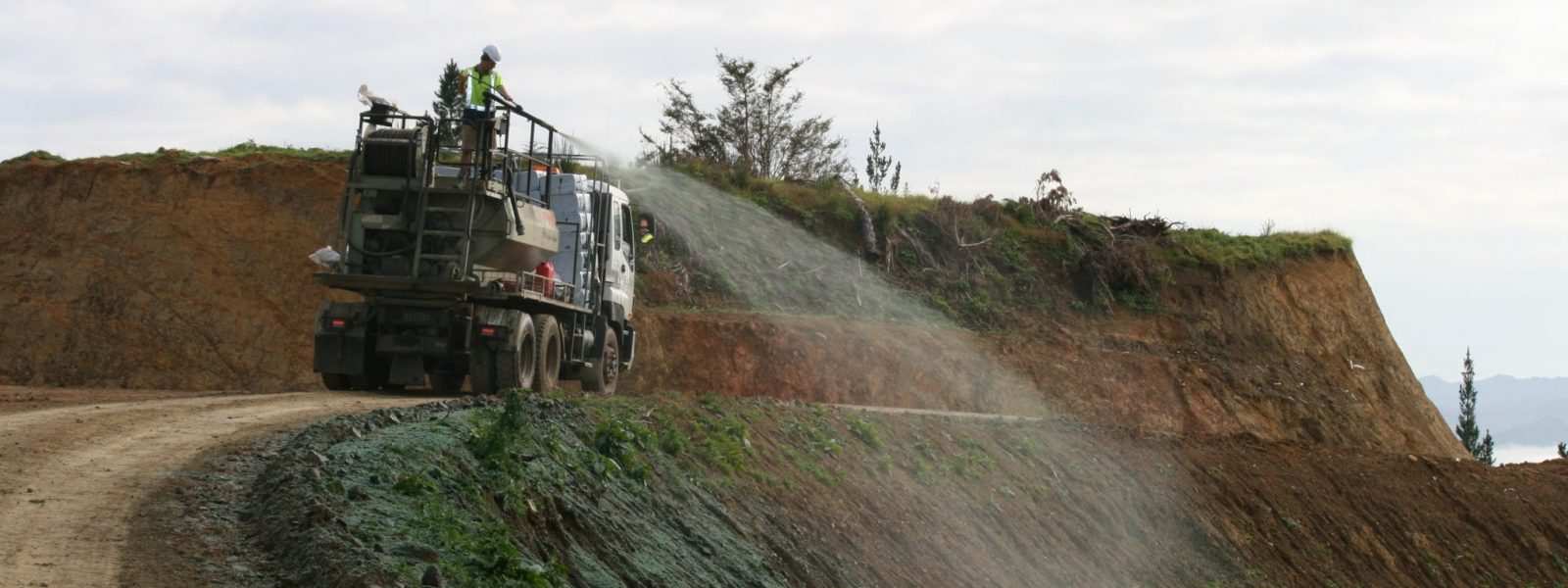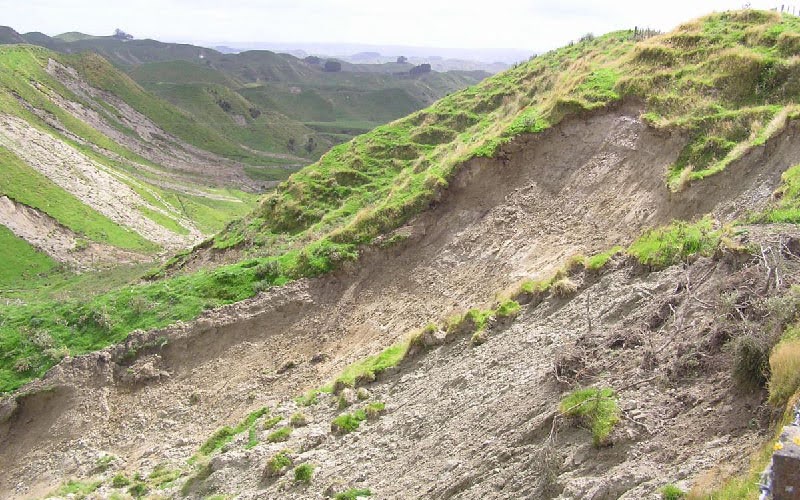Why Erosion Matters Now in NZ
Every year, an estimated 180-200 million tonnes of soil slips, washes or blows off Aotearoa’s hills, gullies and riverbanks and into waterways and harbours. That is among the highest per-capita soil-loss rates in the OECD, and it keeps rising as storms intensify and land uses shift.
Hill-country erosion alone drains NZ $100-150 million in lost production, damaged roads and clogged drains each year, not counting the downstream cost of muddy estuaries or drinking-water treatment.
How Erosion Shapes (and Damages) the Landscape
1. Lost Fertility and Food Security
The nutrient-rich topsoil that feeds our dairy, horticulture and forestry sectors is the first to go. Research on Wairarapa hill farms shows pasture yields on slip scars can fall to 20% of pre-erosion levels even decades later.
2. Sediment-Choked Rivers and Harbours
Fine sediment clouds water, blocks light, smothers kōura and whitebait habitat and accelerates harbour infilling. Stats NZ recorded about 182 million tonnes of soil entering rivers in 2022.
3. Climate Feedbacks
Exposed subsoils release stored carbon, while increased flood flows transport organic matter out to sea. Scientists estimate up to 11 million tonnes of soil-organic carbon may leave New Zealand catchments annually.
4. Infrastructure and Community Risk
Slips after extreme rain damage state highways, stop-banks and homes, as seen during Cyclone Gabrielle. Rebuilding costs far exceed the price of preventative planting or mulching.
Why Erosion Is So Aggressive in Aotearoa
- Soft rock geology: Mudstone and volcanic ash weather quickly.
- Steep terrain and high rainfall: Many hill slopes exceed 30 degrees and receive 1.5-3 metres of rain a year.
- Historical deforestation: Converting deep-rooted native forest to shallow-rooted pasture or pine removes natural anchors.
- Intensified land use: High-stocking rates and cultivation leave bare ground at the worst time, autumn and early spring storm seasons.
- Climate change: Warmer seas fuel heavier rain and more frequent ex-tropical cyclones.
Four Common Types Of Erosion Seen Around the Country
| Erosion Type | Typical Locations | Key Trigger |
| Sheet & wind | Canterbury light soils, coastal dunes | Grazing and cultivation leave soil bare in NW winds |
| Rill & gully | Pumice slopes of the Volcanic Plateau, East Coast sandstone | High-intensity rain scours channels |
| Mass movement (slips) | Gisborne and Tairāwhiti hill country, Wellington papa | Soil saturation during prolonged rain |
| Streambank retreat | Waikato, Northland rivers | Stock trampling and flood peaks undercut banks |
National Direction: From the RMA to the New NES for Commercial Forestry
Regional councils now map highly erodable land and can require planting, stock exclusion or restricted earthworks on vulnerable slopes. The updated National Environmental Standards for Commercial Forestry also set stricter rules for harvest sequencing and woody-debris management on soft rock hill country.
Practical Ways to Combat Erosion
Below are proven controls ranked from most sustainable to most site-specific. Enviro360 delivers erosion control services in-house, giving landowners a single point of contact from planning to maintenance.
1. Rebuild Vegetative Cover with Hydroseeding
Hydroseeding sprays a slurry of certified seed, fertiliser, tackifier and protective mulch that bonds to the surface, germinates fast and knits soil together. Native or amenity mixes can be tailored to local climate, and additives such as ProGanics® jump-start microbial activity on poor subsoils. Ideal for road batters, subdivision cuts and slip scars.
2. Lock in Moisture and Fines with Hay Mulching
Hay mulching A 25-50 mm layer of straw or hay laid over freshly seeded ground shields seedlings from rain splash, cuts evaporation and stops dust. On gentle slopes it is the quickest, cost-effective blanket until deeper roots develop.
3. Stabilise Dusty Roads & Yards with Dust Suppression
Our synthetic, water-free dust suppressants bind fine particles for up to 12 months, reducing grader passes and filter blockages while meeting ISO environmental standards. Perfect for skid sites, forestry haul roads and quarry access tracks where sediment generation is high.
4. Riparian and Streambank Planting
Strategic willow, poplar or native kānuka plantings slow river energy, trap sediment and shade out weeds. Pair-planting poles down the gully floor can stop headward erosion and protect valuable flats.
5. Slope Engineering and Drainage
Flumes, debris dams and sub-surface drains redirect run-off away from slip-prone hollows. Where tunnel gullies form in loess soils, Enviro360 can infill and compact with earthworks before applying a hydroseed cap.
6. Pasture and Stock Management
Rotational grazing, retiring the steepest land and controlling browsing pests keep plant cover intact and reduce pugging. Dense, deep-rooted pasture like cocksfoot and lucerne offers better hold than traditional ryegrass on dry faces.
Putting It All Together: Integrated Solution To Erosion Control
- Assess: Map highly erodable land classes and run UAV or LiDAR scans to locate active slips and gullies.
- Prioritise: Treat areas delivering sediment directly to streams first, then address slower hill-face erosion.
- Combine treatments: Use hydroseeding plus Flexterra® on steep cuts, hay mulch on benches and polymer suppressant on haul roads.
- Monitor and maintain: Inspect before and after major rain, re-spray bare patches, and thin pole stands to avoid wind-throw.
- Report: Keep photo-point records and sediment-trap data to satisfy council consent conditions and demonstrate continuous improvement.
The Enviro360 Difference
- Local knowledge: Decades stabilising Northland and Auckland’s soft volcanics, sands and clay loams.
- ISO-accredited products: All mulch, tackifier and dust suppressant blends are environmentally neutral.
- End-to-end service: From soil testing and seed selection to post-storm inspections.
- 100% satisfaction guarantee: We stand by every project and provide free troubleshooting advice for its life cycle.
Take Action Today
Erosion is not an abstract geological process. It is topsoil in the harbour, silt in the water supply and potholes on the forestry road. New Zealand can reduce those impacts through smart vegetation, modern hydraulic applications and good land stewardship.
Ready to safeguard your land, waterways and bottom line? Call Enviro360 on 09 435 0755 or enquire online for a free erosion-control appraisal tailored for your site. Together we can keep the soil where it belongs, supporting healthy forests, farms and communities.

